Homes | Utilities | Shops & Services | Recollections
Longniddry has become by far the largest settlement in the old parish of Gladsmuir. There are a number of farms in the area that would consider themselves linked to Longniddry in some sense, although several of them are outwith the parish of Gladsmuir.
A mile to the west of Longniddry the farm of Seton Mains has itself become a small village centred on a converted steading and renovated cottages. Chesterhall nearby has been similarly reinvented on a smaller and more tasteful scale.
Longniddry grew only very slowly in the 20 years after the end of the second world war, a trend not continued thereafter. The land built on between 1945 and 2000 was all prime agricultural land.
Further council houses were built between the wars in John Knox Road and Amisfield Place. After the second world war, the council extended Amisfield Place with a street of prefabs, prefabricated metal temporary houses containing the unheard-of luxuries of fridges and partial central heating. More council houses were built in the 1950s in Wemyss Road; the first stage – all Orlits – was built of rather ugly concrete blocks. These council houses all had large gardens, since it was expected that families would wish to grow their own vegetables.
Almost every household had a large vegetable garden. Meals tended to be prepared from raw materials much more than they are today. The main meal in most families in post-war Longniddry was usually in the evening, although some people had the main meal in the middle of the day. The emphasis was on good solid plain cooking.
I always made porridge in the morning. Dinner was always at night. Always soup – all kinds of vegetables, lentil soup. Stovies. We loved our stovies … Steam puddings, well, dumplings -clootie dumplings … Lots of plain cooking. They really liked that. We had loads of vegetables because we had the allotment. Cakes, scones of course, biscuits, fly-cakes … We grew all our own fruit – blackcurrants, redcurrants, strawberries, raspberries of course. I think sometimes it was healthier living than it is nowadays.
Mrs J Robertson
It was mainly soup. And we all grew our own vegetables of course. Everybody had a garden. The meal was at night. Just the usual – stew, and mince, mince and tatties. What else? We would have fish …
Anon
The ‘prefabs’ built after the war had kitchens with built-in fridges and electric cookers, and had partial central heating with the unheard-of luxury of a heated towel rail in the bathroom. The council houses built in Wemyss Road in the 1950s had a Raeburn, a coal-fired cooker, in the kitchen.
In the post-war years there were no houses in Longniddry without hot and cold running water, a bath, and an indoor lavatory.
Nevertheless,
A bath once a week was still deemed sufficient for some children in the 1950s, and if you ventured too close in the classroom your nose would tell you that this was more than one or two fellow-pupils got.
The council replaced the prefabs with Church Way in 1967, and built Forthview Road in several stages in the 1960s and 1970s. The last council houses to be built were Park View and, in 1985, the pensioners’ houses in Wemyss Place.
Apart from the arrival of television, domestic life in Longniddry had not changed dramatically between 1945 and 1965. The following attempt to convey a sense of daily home life in post-war Longniddry applies primarily to what was known as ‘the Village’. The great majority of households in post-war Longniddry were centred round the nuclear family of husband, wife, and one to three children. Large families were by that time a thing of the past, although some households contained an elderly relative. In most homes the husband was the breadwinner, and the woman was above all a housewife and mother. Married women did not usually work until their children were at school, and often not even then.
It should be remembered that although much of ‘the Village’ was made up of council houses, this was a very different environment from the stereotype housing scheme which tends to spring to mind at the mention of council housing in this day and age. Certainly most of the men were working class, but the jobs they did were many and varied, and there was quite a leavening of clerical, professional, and small businessmen in ‘the Village’. Many men still worked locally.
There was not much attractive work for women in the Longniddry area. There was a limited amount of work in local businesses for women with clerical skills, and a similarly limited number of shop assistants’ jobs. Market gardening still employed large numbers of women, but this kind of work tended to be avoided by Longniddry housewives. Many women in ‘the Village’ did part-time housework for their wealthier counterparts in Kings Road and Gosford Road. It was certainly not usual for housewives and mothers to have careers, although there were occasional exceptions to the rule.
Since young couples embarking on marriage in the 1940s and 1950s did not usually have much spare money, and the innovation of hire purchase took a while to catch on, furniture was often second-hand, or donated by or inherited from relatives.
Well, at that time most people had second-hand furniture, if I can remember. They couldnae afford to buy anything else … Most of mine was my mother’s.
Anon
It [furniture] was rather sparse, I would say. No carpets of course. Only lino … Well, when I look back we had iron bedsteads. But these are all fashionable nowadays, aren’t they?
… This living-room was used as a bedroom. And we lived in that. We had a bed settee eventually, which was great, wasn’t it?
Mrs J Robertson
Housework in post-war Longniddry was a laborious business:
Down on your knees to keep your living-room floor clean as well. If you felt like it you polished the lino …
Washing! That was something! Can you remember the wash boilers in the kitchen, David? In the corner? You had to light a fire underneath it and you got hot water and you boiled your whites, you see … and then you had scrubbing boards to scrub the clothes with. I was quite lucky, I got a glass scrubbing board. I still have it. It’s out in the shed … I didn’t get a washing machine till the late fifties/early sixties.
Mrs J Robertson
At Redhouse it was very easy because there was a boiler built into the kitchen and you could fill that up. Put the wood underneath and get the water heated up that way … I’m trying to remember how I washed in the Main Street. It was a washing board! And a wringer. It’s so simple now with machines!.
Anon
Cooking was a much more labour-intensive operation in post-war Longniddry than it is today. In the years immediately after the war not all of the Main Street cottages had electricity, and although all the council houses built before the war in Longniddry did have electricity, not everyone had an electric cooker. The houses had a large cast-iron range in the living room/kitchen. Trivets allowed the housewife to cook over the open fire, and flues heated an oven built into the range.
No central heating. There was a range. You did the cooking on that as well. It was a great thing. I got an electric cooker – the boys must have been getting on. It would be in the fifties. We used to make jam and everything on the range.
Mrs J Robertson
We came from Redhouse to the Main Street. They had paraffin at that time, no electricity there … I can remember when they put the electric in, getting an electric kettle. I thought that was marvellous.
Anon
Labour saving devices and luxuries came slowly:
I remember getting a ‘carpet square’. Oh, I thought that was wonderful. And that led to a hoover. So I got a second-hand old-fashioned Hoover. That was something!
Mrs J Robertson
We had a wireless, and Tom Greig (the garage proprietor) used to – ken these accumulators? There were two of these accumulators, and every week one was put into the garage to be charged … Tom Greig was the first to get a television. And then Billy’s mother and father. They got the television for … the Coronation.
Anon
A handful of households had television in time for Queen Elizabeth’s coronation in 1953. Children would gather in the evenings to watch television in the houses of their more fortunate neighbours. However, the open-house policies and generous invitations to come in anytime soon became less freely offered. Television quickly gained in popularity, and by 1960 probably most households had it.
Private house building picked up in the 1960s. Gap sites between the 1920/30s villas continued to be filled after the second world war, and latterly some owners of houses with spacious gardens began to sell off plots for further building. Almost all these private houses were traditional in design – brick-built, harled and whitewashed, with pitched roofs of slate or tile.
Meanwhile, private building began in the early 1960s to the west of Links Road, on 68 acres of land that the Wemyss Estate earmarked for development. Glassel Park began as a gradually evolving estate of individually designed houses, some of them sporting the flat roofs, which were all the rage with the architects of the day. However, when the plots were not selling fast enough for the Estate’s liking, the ground was sold to Cruden, and the fields around Longniddry House and Longniddry Gardens quickly filled with mass-produced ‘identikit’ housing – detached, harled, tile-roofed, cottage-type homes with small gardens – which swept over the site, at a substantially greater density than had originally been planned.
A third phase extended the building westwards over the old Dean Road to Longniddry Dean, the boundary with Seton Mains farm. Meanwhile, Wimpey filled in the remaining vacant land on the east side of the village with similar private building. This formed a lengthy extension to Douglas Road. At around the same time the ground that had belonged to Elcho Nurseries was also built over behind Church Way.
Much of the housing thus produced looks fairly run-of the-mill and undistinguished. Almost all Longniddry’s family homes are detached or semi-detached houses with gardens, and there are no houses taller than two storeys. Monotony is avoided by the efforts of the homeowners to express their individuality through their gardens; Longniddry has become the very epitome of the leafy suburb; attractive to look at and pleasant to live in.
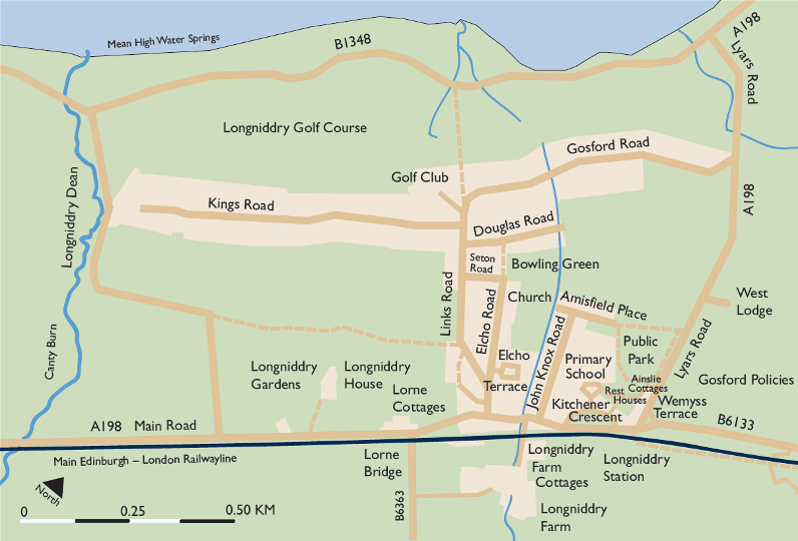
Housing Expansion: Longniddry c.1945

Housing Expansion: Longniddry late 1950s
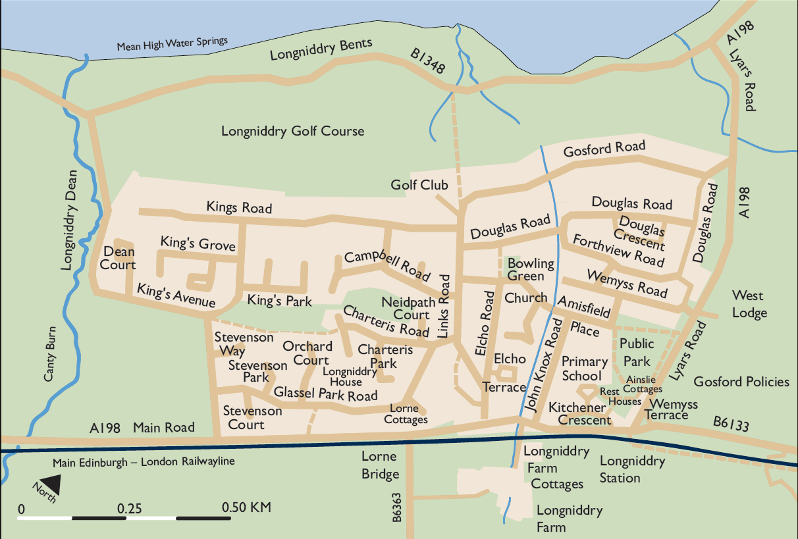
Housing Expansion: Longniddry early 1970s
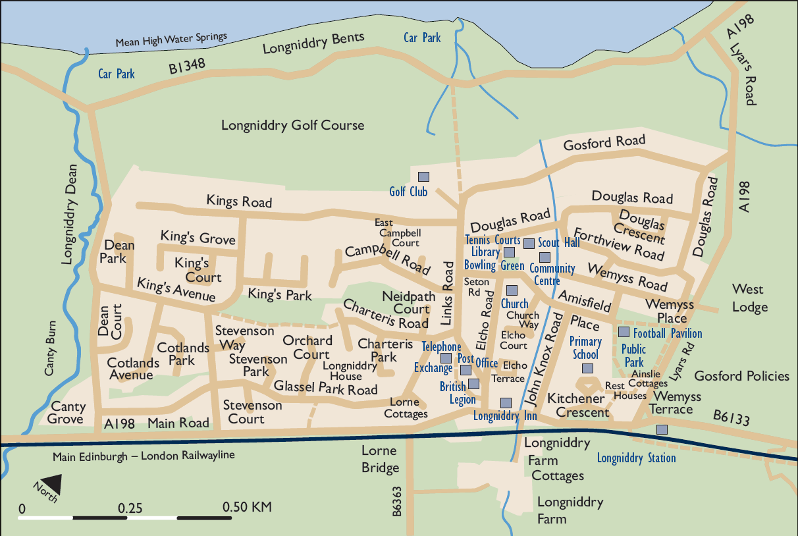
Housing Expansion: Longniddry late 1990s
The expansion of private housing which began slowly in the mid 1960s, gathered pace around 1970, until all available farmland had been filled between Longniddry Dean to the west, Gosford Estate to the east, the golf course to the north, and the railway to the south.
This more than quadrupled the size of the village, and radically altered its social composition.
It is also fortunate that Longniddry’s expansion came to an end before building firms in Scotland enthusiastically embraced the English obsession with building in hideous raw ginger or yellow facing-brick. Suburban Longniddry may not altogether be a place of sublime beauty, but it is infinitely easier on the eye than the closely-crammed brick or mock-Tudor rookeries which have been rattled up elsewhere across the Lothians.
Between 1961 and 1981 Longniddry’s population trebled. The village is now virtually a dormitory suburb of Edinburgh for the clerical, professional, and executive middle classes.
During the 1990s a scheme emerged to build a ‘new town’ on a vast tract of farmland, stretching from Longniddry up to Hoprig. This caused outrage among most Longniddry residents, and it was eventually refused planning permission. A suspicion remains, however, that the threat has not entirely gone away, and that the building firms will be back in the future, perhaps with a succession of smaller-scale plans which will gradually nibble away Longniddry’s rural setting.
Utilities
Raw sewage was discharged into the sea until the late 1950s when a sewage treatment plant was built on the Coast Road just east of the junction with Lyars Road. Treatment was only partial, however, and effluent continued to be discharged into the sea through a new outlet at Ferny Ness.
Longniddry beach suffered greatly from sewage pollution in the period 1945 2000, and became so notorious for this that nowadays, in spite of fine stretches of sand, few people would venture into the water. The nadir came in the summer of 1999 when the water off Longniddry beach was found to contain an incredible 100 times the level of sewage-derived bacteria recommended by the EU, and East Lothian Council posted notices warning against bathing.
A new sewage system taking waste to Seafield from Port Seton, Prestonpans and Musselburgh was completed in 2000, and improvements have also been made to the Ferny Ness treatment plant, so the situation should improve. At the time of writing however, Longniddry beach is still not fit to be classified as a bathing beach according to EU standards.
Throughout the period, Longniddry has been connected to the public water supply and, apart from certain Main Street cottages, which were not connected until c1950, all homes had been connected to mains electricity. The village was long without mains gas, which only became available in the 1980s.
All homes in the village can receive terrestrial and satellite television, and mobile phones can be used in the area. A mobile phone mast recently appeared at the Coal Road crossroads half a mile to the south of the village. All streets have had street lighting, regularly upgraded.
There has been a rubbish collection throughout the period; the council has recently started a waste paper collection. There was a bottle bank for several years outside the Links Road shop, which is now the vet’s surgery, and one beside the tennis courts off Douglas Road. At the time of writing (October 2001) there are no bottle banks in the village.
Shops & Services
Longniddry’s main role throughout the period 1945-2000 has been as a dormitory settlement for those working elsewhere, rather than as a centre of employment, although until the 1960s and 1970s some local employment was available on the land and the railway.
In the 1940s and 1950s, Longniddry residents certainly did most of their shopping for food and other domestic necessities in the village. It was also a shopping centre for nearby farms. However, in the final decades of the 20th century, car owners began to buy in bulk from superstores within easy driving distance.
The commercial centre of Longniddry became more concentrated on the south end of Links Road in the 1970s, with the building of a row of new shops near the already existing Stuart’s grocer’s shop and the Co-operative store. By this time, some other retail businesses elsewhere in the village had given up or moved, and several cottages, a shop, and a smiddy on the Main Street were being developed as the Longniddry Inn (a pub/restaurant).
In the 1940s and 1950s there was not of course the vast range of instant meals available which we are used to at the beginning of the 21st century. There were grocers’ shops, a baker, and a butcher in Longniddry, and several vans also served the village.
Most housewives knitted and sewed to some extent. Everyone could darn and mend. Some mothers made many of their own and their children’s clothes. Clothes could be bought new in Musselburgh or Edinburgh, or in the drapery departments of the East Lothian Co-operative Society in Tranent or Haddington. Many children’s clothes however were ‘made down’ from garments outgrown by elder brothers or sisters. Such domestic crafts as knitting, sewing, and dressmaking, along with baking, cooking, and jam-making, were of course encouraged by organisations like the WRI and the Guild.
I used to knit an awful lot. Knitted all the jerseys and things. My aunt used to make things for the children. She was a sewer. I wasn’t so good at the sewing.
Anon
I used to make my own clothes … and for the children. I used to go to – was it, Parkers? Up in Edinburgh. I used to get material – was it Bristo? Near the Infirmary. But often they were made down from other clothes … I loved my fair isle. The boys had fair isle tammies.
Mrs J. Robertson
In the late 1940s and early 1950s, the retail outlets were as follows:
- Links Road – East Lothian Co-operative Society store; bakery (Bruce); hairdresser (Murray) in a small wooden shop.
- Links Road, on the opposite side facing the above – butcher (Gardner); photographer (A. & J. Gordon) – shop and studio.
- Main Street north side – blacksmith (Chirnside); grocer (McDougall); post office (postmaster R. Smith)
- Main Street south side – grocer (Stuart); chemist (Welsh); bank (Royal Bank of Scotland); garage (Longniddry Engineering Coy.)
- Garden City – confectioner and tobacconist (Murray); cobbler (Fraser); confectioner and newsagent (Watt) – wooden shop; chip shop (Hardy) – wooden shop.
- Elcho Road – vegetable shop and market garden (Campbell).
The subsequent history of these premises can be summarised thus:
‘The Store’, Longniddry’s branch of East Lothian Co-op, has remained on the same site, but the original flat-roofed building has been harled and whitewashed, and given a pitched pantiled roof, making it look older than it actually is.
When the Bruce family gave up the bakery in the 1950s, the premises were taken over and thoroughly modernised by Stuart the grocer. By the 1980s the growing tendency of Longniddry people to shop in superstores was beginning to tell on this formerly flourishing business. Mr Stuart retired in failing health, and the premises became a Spar shop for a time. After standing empty for over a year, it has now become a veterinary surgery – Village Vets.
Mr Welsh, the chemist on the north side of Main Street, was also an optician. He took over the little wooden shop next to The Store for this side of his business c1950: the large eye, painted on the window, was the village’s only distinctive shop sign. When he retired as a chemist, his shop reopened as a dentist’s surgery in 1974. Mr Welsh kept on his optician’s practice and rehoused it in a cottage at the Longniddry Farm road-end, continuing until the 1980s.
When he retired the business was briefly conducted by another optician, after which the premises housed a video shop, then a garden supplies shop. This cottage and the adjoining one are now occupied by a business, which in spring and summer is Gwen’s Gifts and Garden Furniture, and in autumn and winter is Gwen’s Xmas Shop.
Gordons’ shop and photography studio opposite the Co-op were demolished c1960, and the butcher’s shop some time before that.
The Royal Bank of Scotland still occupies the same premises in the Main Street, a sub branch operated by the Haddington branch. It opens two mornings and two afternoons in the week. It has operated in these premises throughout the period 1945-2000, and always on a part-time basis.
Stuart the grocer’s original shop in the Main Street became a bakery run by Jean Stuart. No baking was done on the premises, however, and her wares were all bought in. When Miss Stuart retired the shop was taken in by the dental surgery next door.
In the 1940s and 1950s, there was a flourishing blacksmith‘s business in Main Street, run by the Chirnside family. There were still many horses from neighbouring farms to be shod, and much to do in repairing and maintaining farm implements, gates and other equipment. The blacksmith’s hammer, along with the crowing of cocks, was one of the familiar early morning sounds of post-war Longniddry, and the smell of burning horse hooves used to drift across the entire village. Drew Chirnside died young in 1959, and his successor, a Mr Smith, did not shoe horses on the premises. He also died prematurely. The smiddy was briefly a pottery, before becoming part of the Longniddry Inn in the early 1970s.
When grocer Mr McDougall retired c1960 his shop on Main Street was taken over by A. & J. Gordon, photographers. These premises too were incorporated in the Longniddry Inn, and the photography business moved to the wooden recreation hall at the head of the Main Street. When the Gordons retired, the former recreation hall became ‘Reva’s’, selling knitwear and children’s clothing.
From the 1920s to the 1960s, the post office was housed in a shop built on to the cottage next to the burn at the foot of the Main Street. Around the late 1960s, the postmaster was dismissed over his involvement in a betting scam. However, apparently he personally was the tenant of the post office premises, and proved awkward about allowing another postmaster in. For a time, therefore, the post office was housed in temporary premises in part of the old scout hut off Douglas Road. In 1972, the post office moved into newly-built premises at the foot of Forthview Road, where postmaster Martin Gordon ran the shop as a post office and grocery store for some 15 years. After he gave up the shop, two postmasters in succession
quickly fell foul of their superiors, and the post office then was moved into one of the Links Road shops, where it still remains. The Forthview Road shop became a doctors’ surgery.
The old post office was demolished during the building of the Longniddry Inn, which incorporated all the buildings on the north side of Main Street from the smiddy down to the burn. Longniddry Post Office is a sub post office, and deliveries and collections are based at Prestonpans.
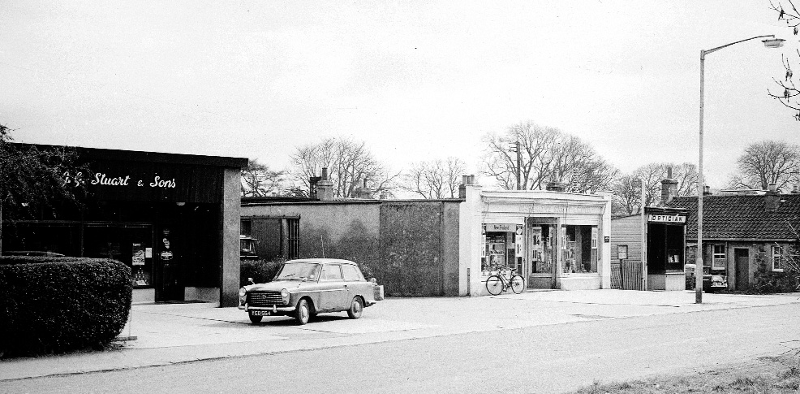
Links Road, 1960s. Stuart’s grocer’s shop (once Bruce’s bakery), now a vet’s surgery. Further along is the East Lothian Co-operative Society. ‘The Store’ nowadays has a pitched, pantiled roof. (A&J Gordon)

Links Road, 1950s. Gordons’ photography business with Gardner’s butcher’s shop on left. (A&J Gordon)
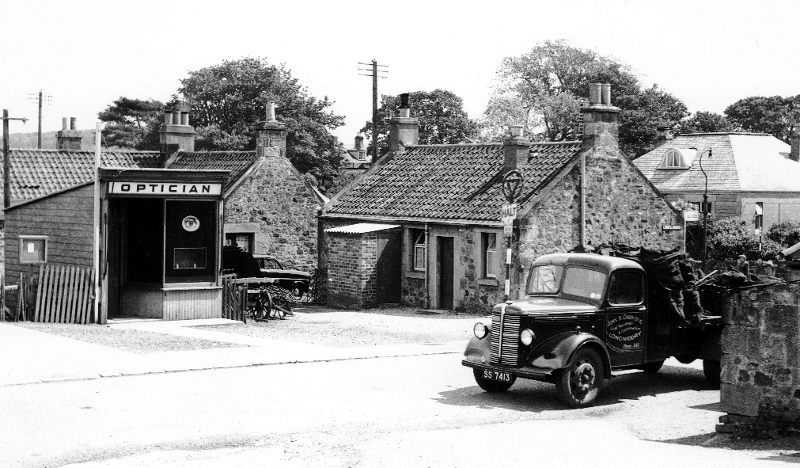
Links Road 1960s. Douglas Welsh’s optician’s premises have long gone. Note Chirnside’s lorry loaded with coal. (A&J Gordon)
The corner shop in the Garden City was taken over as a confectioner/tobacconist’s by Donald Fraser, who retired from cobbling. His cobbler’s business next door was in turn taken over by a Mr McInnes, who did not last long. The corner shop then expanded into the former cobbler’s premises. It was run as a newsagent’s in the early 1960s by a Mr McCabe, and then for many years by Mark Balson. When Mr Watt gave up his wooden shop nearby, Matt Hardy took it over as a confectioner’s and gave up his chip shop. Sometime around the late 1960s Mark Balson took over the wooden shop as a foodstore/greengrocer’s, and ran it in tandem with his nearby newsagent’s shop. After Mr Balson retired, the corner shop was run as a newsagent/greengrocer’s by Margaret Chalmers, and the wooden shop was utilised as a storeroom. The Corner Shop is now run by a couple from Haddington.
The Longniddry Engineering Coy was founded in Main Street by the Greig brothers between the wars. This garage undertook all sorts of car repairs, and hired out limousines for special occasions. The business was bought in the 1970s by MB Alexander, and has traded since then as the more prosaic Longniddry Garage. Longniddry Garage is the only one in the Longniddry area selling conventional motor fuel. Otherwise, the nearest petrol pumps are at Port Seton and Gladsmuir.
The garden ground adjacent to Gwen’s is occupied by a hobby gardener who sells herbaceous perennials and vegetables in season for pocket money.
In the early 1970s, a row of shops was built near the top of Links Road on the west side. The shop nearest Main Street has since then been a newsagent/greengrocer’s, first in the hands of Mr and Mrs Mathie, and subsequently Mr and Mrs Wright. The shop at the opposite end of the block has been a chemist’s since the outset, first run by Mr A Kemp, and now by his daughter. McKirdy, the butcher’s, has also been present from the beginning, but this shop has now closed (2001) as the McKirdy brothers apparently wish to concentrate on their steakhouse restaurant in Edinburgh. Since the 1970s, the hairdresser’s next door has been carried on under various owners – first in the hands of Pauline Tailor, it now belongs to Carole Keegan. The other unit has housed several short-lived enterprises, but for several years now has been Longniddry’s post office (see above).
Mr Campell’s market garden and shop in Elcho Road were taken over by the Crawfords, father and son, and run for several years as Elcho Nursery. The ground was later sold for housing.
Recollections
East Lothian Co operative Society had an important part to play in the community. Universally known as ‘the Store’, in the years after the second world war it was still run on a genuinely co-operative basis. The customers were shareholders, and a careful account was kept of their purchases so that a dividend could be paid to them. This dividend was eagerly anticipated in an era when customers were by no means as affluent as they are now. In the 1940s and 1950s, customers at the Store were served at two counters, one for foodstuffs, and one for firelighters, bundles of kindling, Zebo, Vim, and other household goods. Payment was made at a little glass-fronted office at the far end of the shop. Cooked meat was sliced and weighed according to the customer’s request. Cheese was also cut and weighed to requirements, and sugar and salt scooped into thick paper bags. Nowadays only pre-packed goods are sold. Customers serve themselves from shelves and display cabinets, and pay at a checkout by the door.
McDougall’s grocer’s shop in Main Street did brisk business early in the morning with the squads of female agricultural workers stopping to buy their ‘pieces’. The shop had a distinctive smell of coffee beans and paraffin, canvas sunshades above the windows and, for a time, the village’s only chewing-gum vending machine.
When McDougall’s closed c1960, J. G. Stuart & Sons was left as the Co-op’s only rival. Stuart’s was thought of as being rather more up-market than The Store. Customers could run up hefty accounts, and could have their purchases delivered to their door. Alec Stuart, who took over from his father, was a church elder and session clerk, had a dry sense of humour, and was something of a village character. Small gatherings of favoured friends were allowed discreet evening refreshments in the back shop. Customer loyalty, however, did not survive the wider choice and cheaper prices offered by the superstores that sprang up within easy driving distance from the 1970s onwards, and credit cards soon made the whole business of a grocer’s account an anachronism.
A. & J. Gordon, photographers, operated in the village from the 1930s until the 1980s, and recorded most of the significant events in the life of the community and the lives of the villagers. A large selection of the Gordons’ photographic negatives is now with East Lothian’s Local History Library.
Douglas Welsh, the chemist and optician, was well known in his day as a radio singer, and the inventor and manufacturer of Welsh’s Pink Hand Lotion. His wife, Catherine Meston, was a pianist, and his son, Moray, became a noted cellist (see Miscellany).
Mr Watt, the newsagent, had lost both hands and an arm in the first world war, but could measure out quarters of sweeties from jars with practised ease, and would write up accounts with a pencil held in an elastic band round his wrist. He also painted pottery, which is now quite sought after, and signed his finished pieces with grim irony – ‘Stump’.
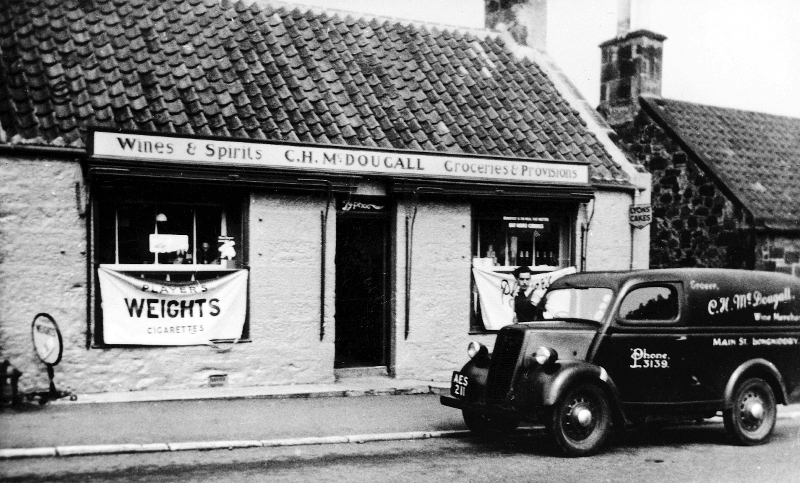
McDougall’s grocer’s shop, Main Street, 1950s, now part of the Longniddry Inn (A&J Gordon)
In the 1950s and early 1960s there were several vans and mobile shops serving Longniddry. East Lothian Co operative Society sent round a ‘Store’ butcher’s van, a baker’s van, and even for a time a draper’s van. There was also a Dickson’s butcher’s van, a Gardner’s butcher’s van, and a Greig’s fish van from Port Seton. A Mr Forsyth also served Longniddry with a baker’s van in the 1950s, and a fruit and vegetable merchant sold his goods from a lorry. From the 1950s until at least the 1970s a Tranent barber, James McCran, came to Longniddry first on a bike, then a moped, and latterly by car, to cut customers’ hair in their own homes.
(This list may well be incomplete).
As people began to shop at superstores, the number of vans and mobile shops declined, and there now appear to be only James Dickson and J.K. Thomson’s fish vans, and a fruit and vegetable van.
Milk was delivered in the early 1950s by the Dumfriesshire Dairy and by East Lothian Co-op, and from then until the 1970s by the Co-op alone. Plastic milk checks were sold in the Longniddry branch of the Co-op, and left out with empty milk bottles to pay for the milk. Many households had a wooden milk-box at the gate to prevent birds from pecking the foil caps of the milk bottles. Sometime around the 1980s, East Lothian Co-op discontinued milk deliveries and their customers were taken over by Robert Wiseman Dairies, who still operate. Milk is now almost always delivered in disposable cartons.
Newspapers are delivered by both Longniddry newsagents. Stuart, the grocer, delivered fresh morning rolls until the early 1960s, but gave the round up as unprofitable.
In the 1950s, every household had a coal fire and required a weekly coal delivery. There were two main coal merchants delivering in the village at this time; McDonald, and ‘Chirnside’ (actually operated by Billy Lamb). Mr McDonald gave up coal deliveries in the late 1950s to become a haulage contractor. When Billy Lamb retired around the 1980s his customers were taken over by Watters of Port Seton. Other coal merchants from nearby communities also made coal deliveries in the last decades of the 20th century, but coal fires are now the exception rather than the rule. However, Mr Watters and Fortune of Macmerry still make coal deliveries in Longniddry.
Door-to-door salesmen were very common in the 1950s, especially Asian pedlars with colourful turbans. ‘Ingan Johnnies’ from France also called. Nowadays the only door-to-door salesmen seem to be Betterware representatives who leave catalogues.
Cafes & restaurants: in the 1940s and 1950s, Matt Hardy ran a chip shop in a wooden hut in his garden at the top end of Wemyss Terrace opposite the station. There were cramped and spartan facilities for a few customers to sit-in. Matt’s was a popular meeting place for village youths in the late 1940s and early 1950s. When Matt gave up the chip shop and took over what had been Watt’s shop next door, he had one or two tables and chairs set out where it was possible to drink a bottle of juice or eat a packet of crisps. This hardy constituted a cafe, however.
The Longniddry Inn has had restaurant facilities since it was built in the early 1970s. It is fair to say that until recently these never realised their full potential, nor were very popular. Standards indeed latterly became so abysmal as to attract the attention of health and safety inspectors. However, the Inn is now in new hands and is currently packed with satisfied diners every weekend.
Building services and tradesmen: George Taylor was a well-known local builder of the 1950s and 1960s, with a yard at ‘Lornlea’, on the main road on the western approach to the old village. Around the same time Eric Robertson ran a flourishing painter’s business from premises in Links Road. In the immediate post-war years, a yard belonging to famous East Lothian builder Richard Baillie was situated behind the west end of the Main Street. Baillie’s plumber, Mr Hunter, was based in the old school building nearby which now houses the Royal British Legion.
Boarding kennels have been operating for some years in premises behind the railway, near Longniddry Station. There are several gardeners and landscape gardeners in Longniddry, but the only one with business premises in the village is Hard Graft on the Main Street.
At the present time there are several businessmen and self-employed tradesmen who live in Longniddry, but none as far as I am aware who have commercial premises in the village.
Outwith the village, a shopfitter‘s business is based at Seton Mains to the west of the village, and a civil engineering contractor at St Germains Level Crossing nearby. Just to the east of the village, the premises of J. McDonald (haulage contractor) were acquired in the 1970s by Iain Tait, and run as the Kiln Garage. The present proprietor is Eamonn Keiller, who undertakes most kinds of car repairs, but recently stopped selling petrol as it had become uneconomical.
An auto-electrician operated until this year in the former premises of Robertson the painter in Links Road. This business has now moved out to the former Sports Tune garage at Seton, and the Links Road premises have been taken over by a car repair business trading as Mill Garage.
Seton Engineering recently set up business at Seton Gardens, at the west end of the dual carriageway. They specialise in converting cars to run on liquid petroleum gas, for which they are the only outlet in the area.
There is a well-camouflaged scrapyard on the site of the former Glencairn colliery, just to the west of the village, where second-hand car parts can be bought, and scrap cars disposed of.
There has been a public phone box in the Main Street, beside the bank, throughout the period 1945-2000. It is one of the old-fashioned red boxes. In 2000 an additional new phone box was placed at the foot of the approach road to the station.
There are public toilets at two of the coastal car parks. These are usually closed in the winter. Public toilets were built beside the main road on the grass in front of Kitchener Crescent in the early 1960s. However, they were demolished a dozen or so years later, presumably to spare the council the expense of maintaining them. There were also toilets at the station until the 1970s, but they were demolished along with all the other station buildings. There are therefore no public toilets now available in Longniddry.
There are two large car parks on the foreshore at Longniddry, as well as Ferny Ness in neighbouring Aberlady parish; all are very busy in summer. The middle one is apparently a popular homosexuals’ meeting point. The foreshore car parks, especially the one at Ferny Ness, are occasional stopping places for gypsies and travelling people, in spite of the fact that local by-laws expressly forbid overnight camping. There are toilet blocks at two of the car parks.
There is also a large car park at the station, parking facilities at the public park and the Community Centre, and a large grass area beside the church used as a car park for Sunday services. Parking space at the Links Road shops is insufficient for demand, and this area becomes dangerously congested at times. Longniddry Primary School also has had an ongoing problem with parents who insist on disregarding pleas not to set down or pick up children at the school gates in John Knox Road. Car parking elsewhere in the village is not a problem, apart from a bend in Forthview Road where parking in the street is very likely to cause an accident sooner or later.